Search results for: 'good to go pass'
- Related search terms
- good day ep 1
- good room
- good standing
- goods
- good quality paper for printing
-
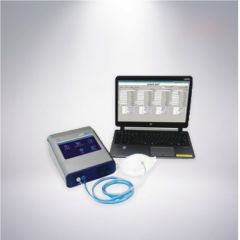 T-6552 MASK AIR TIGHTNESS TESTER
T-6552 MASK AIR TIGHTNESS TESTERREFERENCE NUMBER: T-6552
MASK AIR TIGHTNESS TESTER
MASK AIR TIGHTNESS TESTER
HOW TO CHOOSE A HIGH-QUALITY MASK NOT ONLY DEPENDS ON THE FILTERING EFFICIENCY OF THEMASK, BUT ALSO TO CONFIRM WHETHER THE MASK IS COMPLETELY IN CONTACT WITH THE FACE, OTHERWISE AEROSOL PARTICLES SUCH AS GERMS THAT HAVE NOT BEEN FILTERED BY THE MASK WILL BE INHALED FROM THE INADEQUATE ADHESION. THEREFORE, IT IS VERY IMPORTANT TO CHECK THE WEARING STATUS OF THE MASK. THE EUROPEAN AND AMERICAN COUNTRIES HAVE LISTED THE APPLICATION TEST OF THE MASK AS A STRONG INSPECTION ITEM.
FOR EXAMPLE, THE N95 MASK IS ONE OF 9 TYPES OF PARTICULATE PROTECTIVE MASKS CERTIFIED BY NIOSH (NATIONAL INSTITUTE OF OCCUPATIONAL SAFETY AND HEALTH). "N" INDICATES OIL RESISTANCE."95" INDICATES THAT THE PARTICLE CONCENTRATION IN THE MASK IS MORE THAN 95% LOWER THAN THAT OF THE PARTICLES OUTSIDE THE MASK WHEN EXPOSED TO THE SPECIFIED NUMBER OF SPECIAL TEST PARTICLES. N95 IS NOT A SPECIFIC PRODUCT NAME, AS LONG AS IT MEETS THE N95 STANDARD AND PASSES THE NIOSH REVIEW, IT CAN BE CALLED "N95 MASK".
N95 TYPE MASKS, IN ADDITION TO THE FILTERING EFFICIENCY OF THE MASKS, THE CLOSENESS OF THE MASKS TO THE FACE IS ONE OF THE IMPORTANT FACTORS THAT DETERMINE THE EFFECTIVENESS OF THE USE OF THE MASKS. THE SUITABILITY OF DIFFERENT TYPES OF MASKS FOR THE HUMAN FACE VARIES GREATLY.
THEREFORE, BEFORE USING A MASK, THE SUITABILITY OF THE MASK SHOULD BE CHECKED FIRST. DURING THETIGHTNESS TEST OF THE WEARER'S FACE, ENSURE THAT AIR CAN PASS IN AND OUT THROUGH THE MASK WHEN IT IS CLOSE TO THE EDGE OF THE FACE. THE MASK TIGHTNESS TESTER CAN QUICKLY COMPLETE THE TIGHTNESS TEST OF RESPIRATORS SUCH AS MASKS TO ENSURE THAT IT PROVIDES GOOD PROTECTION PERFORMANCE. IT CONFORMS TO THE CHINESE RESPIRATOR STANDARD GB2626-2019 STANDARD, OSHA / CSA STANDARD AND CHINA GENERAL ADMINISTRATION OF QUALITY SUPERVISION, INSPECTION AND QUARANTINE "GB 19083-2010 TECHNICAL REQUIREMENTS FOR MEDICAL PROTECTIVE MASKS" JOINTLY ISSUED BY THE CHINA NATIONAL STANDARDIZATION ADMINISTRATION COMMITTEE.
ADHESION (SUITABILITY TEST): THE MASK DESIGN SHOULD PROVIDE GOOD ADHESION. THE OVERALL FIT FACTOR OF THE MASK SHOULD NOT BE LESS THAN 100. THIS TEST THE REQUIREMENTS WERE FORMALLY IMPLEMENTED ON AUGUST 1, 2011.
Learn MoreMASK TIGHTNESS TESTER USES CNC TECHNOLOGY, SUITABLE FOR 100 / 99 / P3 / HEPASERIES MASKS DISPOSABLE FILTER MASK TIGHTNESS TEST (INCLUDING DISPOSABLE DUST MASKS SUCH ASN95 / N90 / KN95), GAS MASKS / BREATHING MASKS, ADHESIVENESS TEST OF HALF-MASK AND FULL FACE MASK, INDEPENDENT OR COMPUTER CONTROL, FIVE LANGUAGES SWITCH DISPLAY, EQUIPPED WITH MULTIPLE COMMUNICATION INTERFACES (USB, ETHERNET), WIFI CAN ALSO BE ENABLED, ONE COMPUTERCAN CONTROL FOUR INSTRUMENTS AT THE SAME TIME.PARAMETER:CONCENTRATION RANGE: 0 ~ 100,000 / CM3GRAIN DIAMETER: 0.02 ~ 1.0^MFLOW: SAMPLING FLOW: 100CM3 / MINTOTAL FLOW: 700CM3 / MINCLOSENESS COEFFICIENT TEST: DIRECT TEST (COUT/ CIN)LIQUOR: 99.5% + ISOPROPANOL (ANALYTICAL GRADE)DISPLAY: 7INCH TRUE COLOR TOUCH SCREENCOMMUNICATION INTERFACE: USB X 3 (HOST X 2,DEVICE X 1) ETHERNET INTERFACE X1CONNECTION PORT: ENVIRONMENT PORT, SAMPLING PORTWIFI: EQUIPPEDLANGUAGES: ENGLISH, FRENCH, SPANISH, PORTUGUESE, CHINESEFLOW CONTROL: SENSOR CONTROLPC CONTROLLABLE OPERATION: ONE COMPUTER CAN CONTROL 4 INSTRUMENTS AT THE SAME TIMEDATA OUTPUT FORMAT: MICROSOFT EXCELWORKING TEMPERATURE: 15 ~ 35 °CPOWER SOURCE: AC 110 —240V 50 / 60HZAPPEARANCE SIZE: 208 X 117 X 262MMWEIGHT: 2.1KGACCESSORIES: ALCOHOL REAGENT BOTTLE, PROTECTIVE CAP, REAGENT STICK, ZERO-COUNT FILTER, STRAINER, SAMPLING TUBE, INSTRUCTION MANUAL, AC ADAPTER, TOUCH SCREEN PEN, OPTIONAL COMPUTER.OPTIONAL: TEST KIT FOR TIGHTNESS COEFFICIENTIN ORDER TO PREVENT INFECTION AT THE MEDICAL SITE AND DURING LABOR WORK, WORKERS MUST BE PROTECTED FROM INHALABLE HAZARDOUS SUBSTANCES IN THE WORKPLACE, AND RESPIRATORS SUCH AS MASKS MUST BE WORN DURING WORK.SELECT A RESPIRATOR, SUCH AS A MASK, BASED ON YOUR FACIAL FEATURES, AND EVALUATE THE TIGHTNESS BETWEEN THE RESPIRATOR, SUCH AS A MASK AND THE FACE, TO CHECK WHETHER THERE ARE GAPS OR LEAKS THAT PUT WORKERS AT RISK. THE MASK TIGHTNESS TESTER CAN QUICKLY COMPLETE THE TIGHTNESS TEST OF RESPIRATORS SUCH AS MASKS TO ENSURE THAT IT PROVIDES GOOD PROTECTIVE PERFORMANCE. SECURITY EXPERTS WILL ALSO DEVELOP PROTECTION SCHEMES AND STANDARD REGULATIONS BASED ON THE RESULTS OF THE TIGHTNESS TEST. WIDELY USED IN HOSPITALS, MANUFACTURING PLANTS, PRODUCTION SITES, FIREFIGHTING WORKPLACES AND OTHER OFFICIAL TESTING AGENCIES.MASK TIGHTNESS TESTER FEATURES:• QUANTITATIVE TIGHTNESS TEST FOR RESPIRATORS SUCH AS MASKS (QNFT)• APPLICABLE TO 100/99 / P3 / HEPA SERIES MASK DISPOSABLE FILTER MASK TIGHTNESS TEST (INCLUDING N95 / N90 / KN95 AND OTHER DISPOSABLE DUST MASKS)• ADHESION TEST OF HALF MASK AND FULL FACE MASK• GAS MASK TIGHTNESS TEST• PAPR MASK TIGHTNESS TEST• SCBA RESPIRATOR MASK TIGHTNESS TEST• 7INCH TRUE COLOR TOUCH SCREEN• INDEPENDENT OR COMPUTER CONTROLLED• USING CNC TECHNOLOGY• ENGLISH, FRENCH, SPANISH, PORTUGUESE, CHINESE LANGUAGE SWITCHING DISPLAY• COMPLIES WITH US OSHA STANDARDS, CANADIAN STANDARDS ASSOCIATION (CSA) GUIDELINES, INCLUDING N95• EQUIPPED WITH A VARIETY OF COMMUNICATION INTERFACES (USB, ETHERNET), AND CAN ALSO ENABLE WIFI• ONE COMPUTER CAN CONTROL FOUR INSTRUMENTS AT THE SAME TIMEQUANTITY: 1 -
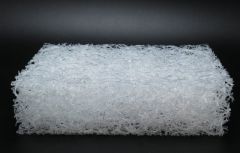 M-0809 HIGH POLYMER MATTRESS 25 TO 200mm TALL (POLYMAT)
M-0809 HIGH POLYMER MATTRESS 25 TO 200mm TALL (POLYMAT)REFERENCE NUMBER: M-0809 HIGH POLYMER MATTRESS 25 TO 200mm TALL (POLYMAT) QUANTITY AVAILABLE: 1
Learn More -
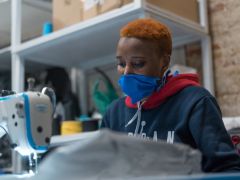 D-2388 What’s the Best Material for a Mask?
D-2388 What’s the Best Material for a Mask?Federal health officials have now recommended that we cover our faces with fabric during the coronavirus pandemic. But what material offers the most protection?
The Centers for Disease Control and Prevention has posted a no-sew mask pattern using a bandanna and a coffee filter as well as a video on making masks using rubber bands and folded fabrics found at home.
While a simple face covering can reduce the spread of coronavirus by blocking outgoing germs from coughs or sneezes of an infected person, experts say there is more variation in how much homemade masks might protect the wearer from incoming germs, depending on the fit and quality of the material used.
Scientists around the country have taken it upon themselves to identify everyday materials that do a better job of filtering microscopic particles. In recent tests, HEPA furnace filters scored well, as did vacuum cleaner bags, layers of 600-count pillowcases and fabric similar to flannel pajamas. Stacked coffee filters had medium scores. Scarves and bandanna material had the lowest scores, but still captured a small percentage of particles.
If you don’t have any of the materials that were tested, a simple light test can help you decide whether a fabric is a good candidate for a mask.
“Hold it up to a bright light,” said Dr. Scott Segal, chairman of anesthesiology at Wake Forest Baptist Health who recently studied homemade masks. “If light passes really easily through the fibers and you can almost see the fibers, it’s not a good fabric. If it’s a denser weave of thicker material and light doesn’t pass through it as much, that’s the material you want to use.”
Researchers say it’s important to remember that lab studies are conducted under perfect conditions with no leaks or gaps in the mask, but the test methods give us a way to compare materials. And while the degree of filtration for some homemade masks seems low, most of us — who are staying home and practicing social distancing in public — don’t need the high level of protection required for medical workers. More important, any face covering is better than none, especially if worn by a person who has the virus but doesn’t know it.
The biggest challenge of choosing a homemade mask material is to find a fabric that is dense enough to capture viral particles, but breathable enough that we can actually wear it. Some items being touted online promise high filtration scores, but the material would be unwearable.
Dressing Up for Work … at Home
Yang Wang, an assistant professor of environmental engineering at Missouri University of Science and Technology, worked with his graduate students to study various combinations of layered materials — including both air filters and fabric. “You need something that is efficient for removing particles, but you also need to breathe,” said Dr. Wang, who last fall won an international award for aerosol research.To test everyday materials, scientists are using methods similar to those used to test medical masks, which everybody agrees should be saved for medical workers who are exposed to high doses of virus from seeing infected patients. The best medical mask — called the N95 respirator — filters out at least 95 percent of particles as small as 0.3 microns. By comparison, a typical surgical mask — made using a rectangular piece of pleated fabric with elastic ear loops — has a filtration efficiency ranging from 60 to 80 percent.
Dr. Wang’s group tested two types of air filters. An allergy-reduction HVAC filter worked the best, capturing 89 percent of particles with one layer and 94 percent with two layers. A furnace filter captured 75 percent with two layers, but required six layers to achieve 95 percent. To find a filter similar to those tested, look for a minimum efficiency reporting value (MERV) rating of 12 or higher or a microparticle performance rating of 1900 or higher.
The problem with air filters is that they potentially could shed small fibers that would be risky to inhale. So if you want to use a filter, you need to sandwich the filter between two layers of cotton fabric. Dr. Wang said one of his grad students made his own mask by following the instructions in the C.D.C. video, but adding several layers of filter material inside a bandanna.
Dr. Wang’s group also found that when certain common fabrics were used, two layers offered far less protection than four layers. A 600 thread count pillow case captured just 22 percent of particles when doubled, but four layers captured nearly 60 percent. A thick woolen yarn scarf filtered 21 percent of particles in two layers, and 48.8 percent in four layers. A 100 percent cotton bandanna did the worst, capturing only 18.2 percent when doubled, and just 19.5 percent in four layers.
The group also tested Brew Rite and Natural Brew basket-style coffee filters, which, when stacked in three layers, showed 40 to 50 percent filtration efficiency — but they were less breathable than other options.
If you are lucky enough to know a quilter, ask them to make you a mask. Tests performed at the Wake Forest Institute for Regenerative Medicine in Winston-Salem, N.C., showed good results for homemade masks using quilting fabric. Dr. Segal, of Wake Forest Baptist Health, who led the study, noted that quilters tend to use high-quality, high-thread count cotton. The best homemade masks in his study were as good as surgical masks or slightly better, testing in the range of 70 to 79 percent filtration. Homemade masks that used flimsier fabric tested as low as 1 percent filtration, Dr. Segal said.
The best-performing designs were a mask constructed of two layers of high-quality, heavyweight “quilter’s cotton,” a two-layer mask made with thick batik fabric, and a double-layer mask with an inner layer of flannel and outer layer of cotton.
Bonnie Browning, executive show director for the American Quilter’s Society, said that quilters prefer tightly woven cottons and batik fabrics that stand up over time. Ms. Browning said most sewing machines can handle only two layers of fabric when making a pleated mask, but someone who wanted four layers of protection could wear two masks at a time.
Ms. Browning said she recently reached out to quilters on Facebook and heard from 71 people who have made a combined total of nearly 15,000 masks. “We quilters are very much in the thick of what’s going on with this,” said Ms. Browning, who lives in Paducah, Ky. “One thing most of us have is a stash of fabric.”
People who don’t sew could try a folded origami mask, created by Jiangmei Wu, assistant professor of interior design at Indiana University. Ms. Wu, who is known for her breathtaking folded artwork, said she began designing a folded mask out of a medical and building material called Tyvek, as well as vacuum bags, after her brother in Hong Kong, where mask wearing is common, suggested it. (DuPont, the maker of Tyvek, said in a statement that Tyvek is intended for medical apparel, not masks.) The folded mask pattern is free online, as is a video demonstrating the folding process. In tests at Missouri University and University of Virginia, scientists found that vacuum bags removed between 60 percent and 87 percent of particles. But some brands of vacuum bags may contain fiberglass or are harder to breathe through than other materials, and shouldn’t be used. Ms. Wu used a bag by EnviroCare Technologies, which has said it does not use fiberglass in its paper and synthetic cloth bags.
“I wanted to create an alternative for people who don’t sew,” said Ms. Wu, who said she is talking to various groups to find other materials that will be effective in a folded mask. “Given the shortage of all kinds of materials, even vacuum bags might run out.”
The scientists who conducted the tests used a standard of 0.3 microns because that is the measure used by the National Institute for Occupational Safety and Health for medical masks.
Linsey Marr, a Virginia Tech aerosol scientist and an expert in the transmission of viruses, said the certification method for respirators and HEPA filters focuses on 0.3 microns because particles around that size are the hardest to catch. While it seems counterintuitive, particles smaller than 0.1 microns are actually easier to catch because they have a lot of random motion that makes them bump into the filter fibers, she said.
“Even though coronavirus is around 0.1 microns, it floats around in a wide range of sizes, from around 0.2 to several hundred microns, because people shed the virus in respiratory fluid droplets that also contain lots of salts and proteins and other things,” said Dr. Marr. “Even if the water in the droplets fully evaporates, there’s still a lot of salt and proteins and other gunk that stays behind as solid or gel-like material. I think 0.3 microns is still useful for guidance because the minimum filtration efficiency will be somewhere around this size, and it’s what NIOSH uses.”
Learn More -
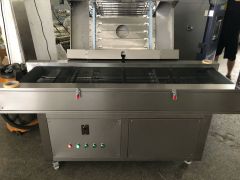 YY-1136 ULTRAVIOLET STERILIZERYY-1136 ULTRAVIOLET STERILIZER MAINTENANCE OF UV STERILIZER: 1 CHECK REGULARLY TO ENSURE THE NORMAL OPERATION OF THE UV LAMP. 2. AFTER 9000 HOURS OR ONE YEAR OF CONTINUOUS USE, THE ULTRAVIOLET LAMP SHOULD BE REPLACED. WHEN REPLACING A NEW LAMP, FIRST UNPLUG THE POWER SOCKET OF THE LAMP AND TAKE OUT THE ULTRAVIOLET LAMP. PAY ATTENTION NOT TO TOUCH THE QUARTZ GLASS OF THE NEW LAMP WITH YOUR FINGERS, BECAUSE THE STAIN WILL AFFECT THE INTENSITY OF THE LIGHT, AND CAREFULLY PUT THE LAMP INTO THE CHAMBER OF THE STERILIZER. Learn More
YY-1136 ULTRAVIOLET STERILIZERYY-1136 ULTRAVIOLET STERILIZER MAINTENANCE OF UV STERILIZER: 1 CHECK REGULARLY TO ENSURE THE NORMAL OPERATION OF THE UV LAMP. 2. AFTER 9000 HOURS OR ONE YEAR OF CONTINUOUS USE, THE ULTRAVIOLET LAMP SHOULD BE REPLACED. WHEN REPLACING A NEW LAMP, FIRST UNPLUG THE POWER SOCKET OF THE LAMP AND TAKE OUT THE ULTRAVIOLET LAMP. PAY ATTENTION NOT TO TOUCH THE QUARTZ GLASS OF THE NEW LAMP WITH YOUR FINGERS, BECAUSE THE STAIN WILL AFFECT THE INTENSITY OF THE LIGHT, AND CAREFULLY PUT THE LAMP INTO THE CHAMBER OF THE STERILIZER. Learn More -
 TT-7585 SIEMENS SST-300 STEAM TURBINE - NEW, YEAR 2021, 50 HzTT-7585 SIEMENS SST-300 STEAM TURBINE - NEW, YEAR 2021, 50 Hz 1. BRAND NEW STEAM TURBINE SIEMENS SST-300 - IN FACTORY 2. PACKING FROM THE YEAR 2021 3. THIS TURBINE HAS NEVER BEEN INSTALLED AND AVAILABLE 4. WITH ALL ITS EQUIPMENT AND ACCESSORIES 5. STORED IN WAREHOUSE SECURELY, IN GOOD ENVIRONMENT. Learn More
TT-7585 SIEMENS SST-300 STEAM TURBINE - NEW, YEAR 2021, 50 HzTT-7585 SIEMENS SST-300 STEAM TURBINE - NEW, YEAR 2021, 50 Hz 1. BRAND NEW STEAM TURBINE SIEMENS SST-300 - IN FACTORY 2. PACKING FROM THE YEAR 2021 3. THIS TURBINE HAS NEVER BEEN INSTALLED AND AVAILABLE 4. WITH ALL ITS EQUIPMENT AND ACCESSORIES 5. STORED IN WAREHOUSE SECURELY, IN GOOD ENVIRONMENT. Learn More -
 TT-5475 ALUMINIUM LANDING CRAFT LCM-8-2565, 75FT, YEAR 1969TT-5475 ALUMINIUM LANDING CRAFT LCM-8-2565, 75FT, YEAR 1969 75FT ALUMINIUM LCM-8 LANDING CRAFT REPORTED IN GOOD OVERALL CONDITION. OPERATIONAL BOW RAMP. 60 LONG TON DECK CAPACITY USED YEAR BUILT: 1969 BUILDER: MARINETTE, WI FOR US GOVERNMENT CLASSIFICATION: NONE REQUIRED CONSTRUCTION: ALUMINIUM GROSS / NET TONS: 110 / 88 # OF PASSENGERS: 0 LOADLINE: NONE REQUIRED Learn More
TT-5475 ALUMINIUM LANDING CRAFT LCM-8-2565, 75FT, YEAR 1969TT-5475 ALUMINIUM LANDING CRAFT LCM-8-2565, 75FT, YEAR 1969 75FT ALUMINIUM LCM-8 LANDING CRAFT REPORTED IN GOOD OVERALL CONDITION. OPERATIONAL BOW RAMP. 60 LONG TON DECK CAPACITY USED YEAR BUILT: 1969 BUILDER: MARINETTE, WI FOR US GOVERNMENT CLASSIFICATION: NONE REQUIRED CONSTRUCTION: ALUMINIUM GROSS / NET TONS: 110 / 88 # OF PASSENGERS: 0 LOADLINE: NONE REQUIRED Learn More -
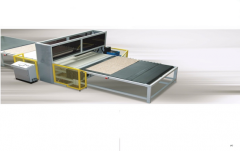 A-2531 HOT MELT GLUE FOR MATTRESS INDUSTRYQUALITY AND TIDY MATTRESS PRODUCTION WITH AUTOMATIC SYSTEM SAVING TIME AND KEEP CLEAN MATTRESS HEALTHY GLUE MATERIAL USAGE – HOT MELT GLUE PROVIDES HIGH – OUTPUT WITH MINIMUM TRAINING TIME Learn More
A-2531 HOT MELT GLUE FOR MATTRESS INDUSTRYQUALITY AND TIDY MATTRESS PRODUCTION WITH AUTOMATIC SYSTEM SAVING TIME AND KEEP CLEAN MATTRESS HEALTHY GLUE MATERIAL USAGE – HOT MELT GLUE PROVIDES HIGH – OUTPUT WITH MINIMUM TRAINING TIME Learn More
